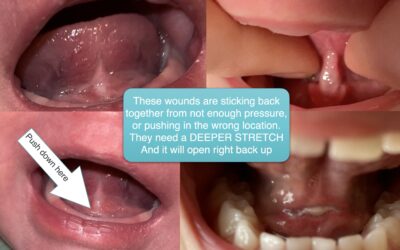Clearly, there is more to treatment than can fit in one post, but here are the highlights. (To get the full story, we’re now giving free digital access to our bestselling book Tongue-Tied to dentists and therapists.)
First, you must have a proper history. What issues are bringing the patient to your office? If there are no issues, they likely won’t even come to see you in the first place. The exception is the to-the-tip variety, in which case they may not realize all the related issues.
Next, you need a proper assessment as we talked about the last two weeks (check a baby and check a child properly). The baby must be on the exam table, dental chair, or knee-to-knee board (my preference). You should come from behind, using two fingers to elevate the lip and tongue, and check the cheks. A child should be on the knee-to-knee board, or dental chair, and come from behind and lift the tongue. You might need a mouth prop so you are not bitten (esp. for ages 1-4)! Check older children and adults the same way, but ask them to lift their tongue.
Proper treatment requires knowledge of the tool you are using. I used a diode laser (iLase) for 18 months before switching to CO2 (LightScalpel) and it’s a night and day difference. The diode takes about 1 minute per tie, the CO2 takes 5-10 seconds for the same tie. On a screaming baby, a minute is like an eternity! We can go more into diode vs. CO2 later, but in essence know that using a diode is a hot tip (thermally necroses tissue at 1000 deg C) and the CO2 optically cuts (vaporization, the tissue turns to water vapor at 100C).
The technique requires tension to the tie, precision (you must be in the right place), the proper shape (depth, width, height, typically a diamond shape), and remove the right amount of tissue to restore function, but not too much in order to minimize trauma to the tissue, minimize discomfort, and lessen the risk of reattachment.
If you don’t do post-op exercises, it will grow back. It’s like if you had your ears pierced, but didn’t wear the earrings, it will close back up. If you make a cut under the lip or tongue but don’t keep that tissue separated multiple times a day, it will grow back together, or even tighter than it was before.
Lastly, proper follow-up. Minimum one week follow up, and more as needed. If you don’t follow up, you don’t know what issues improved and which didn’t. Also, most parents will not perform the stretches enough, and it will be necessary to do a “deeper stretch” in order to restore the mobility the patient had a week ago.
There are about 1,000 more pearls to be discussed, and an easy way to get a headstart on this knowledge is with our best-selling book Tongue-Tied that we are giving away FREE to dentists and therapists for a limited time.
Next week, we’ll talk more about treatment. Stay tuned!



